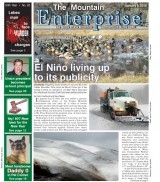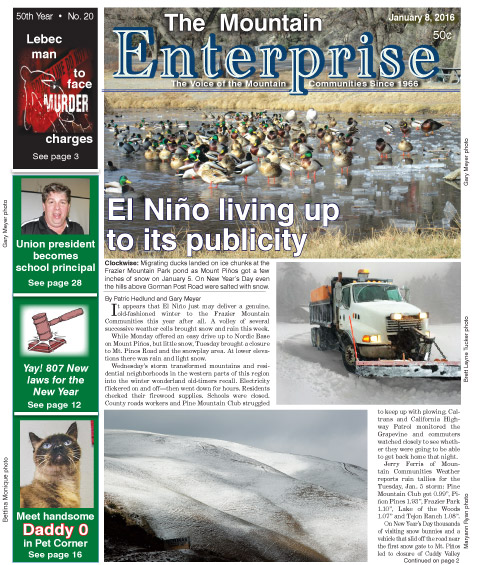UPDATE: A public information meeting will be held January 19, 7 p.m., at the Lake of the Woods Mutual Water Company office (7025 Cuddy Valley Road) to answer shareholders’ questions about the ballot on joining a regional water project. All ballots must be submitted to the water office to be counted at the board’s February 4 meeting.
•What does a regional water project mean?
•How would it be implemented?
•Can water customers be sure they won’t be
asked to sign a blank check?
By Patric Hedlund, from the December 25, 2015 issue of The Mountain Enterprise
There may be two Christmases for the people of Lake of the Woods this winter. The little town became a poster child for California’s drought after production of its main well at Cuddy Hall dropped in April 2013 from 300 gallons per minute (gpm) to 10 gpm. A ban on all outside irrigation, except with gray water, began.
Quick Recap
The state’s rapid response to Lake of the Woods Mutual Water Company’s desperate situation was generous in 2013.
A $250,000 emergency grant put the little town on life support so it could survive while the water company’s board could research long term solutions. Those first funds covered buying and trucking water from other areas to keep the LOW distribution tanks full. That money was also to help search and drill a new well.
But it wasn’t that easy. With the drought getting worse, it seemed all the state’s farmers simultaneously wanted to drill new wells or make existing wells deeper. Even with the money, it was hard to find a good driller available, and their rates went up. LOW had to wait in line. When drillers finally rolled into town, they first set up at Cuddy Hall, to see if making that well deeper might be the magic bullet. The community watched anxiously for signs of success. The Cuddy Hall well was drilled below 700 feet.
“It was just a tall glass of wet sand,” said water manager Rafael Molina, Jr.
Civil Engineer Dee Jaspar would later explain that the fractured rock through which groundwater flows had been ‘dewatered.’ It was dry. They had to search for another spot.
The drilling rig was seen in one location after another in the Cuddy Creek area that fall. News of five dry holes dropped a cloud of discouragement over Lake of the Woods.
The New York Times, National Public Radio (NPR) and NBC News came to report about the hardscrabble Lake of the Woods neighborhoods where all outdoor watering had been banned.
Dave Warner with Self-Help Enterprises (a nonprofit that helps rural communities obtain clean drinking water) helped secure the emergency funds for LOW. He also helped bring in two additional $500,000 grants to try to find water and to make the existing sources more efficient. That helped, but it didn’t provide a real solution.
Warner told LOW and Frazier Park Public Utility District (FPPUD) about a new “pre-planning grant” from the state.
This new category of funding was created to help rural areas with many small water systems to research the feasibility of merging into a regional water system. Receiving such a grant does not create an obligation to merge. It creates an opportunity to do preliminary hydrology and legal research about that idea. The state’s goal is to get small, vulnerable water systems to work together to find regional solutions. For LOW, two years of searching for a viable new well have been unsuccessful, and now the emergency funding is coming to an end. Five dry holes and a sixth which produces only 12 gpm was the result.
The Dark Canyon well was tied into the system. It also supplies 12 gpm. Meanwhile, a new well drilled by FPPUD is yielding 330 gpm of pure water that meets state standards.
The First Gift
The Lake of the Woods Mutual Water Company system was established in 1947. It is now 69 years old. Capital investment in upgrades has been limited until this emergency.
LOW water customers do not have water meters and the majority of the pipes in the system need to be replaced, engineers report.
The good news is that the water company may soon receive $1.4 million from a California Department of Water Resources (DWR) grant, Warner said this week.
Official notification from DWR is set for January 15. The money is to purchase and install about 400 modern water meters and to repair about 4,000 feet of leaky distribution lines by September 2016.
The California Department of Public Health mandated these upgrades. Lake of the Woods also needs a dependable supply of water to put through those pipes and meters to serve its residents. The water company has been ordered to find a reliable and adequate water supply by September also.
The Second Gift
If you own property in Lake of the Woods, watch for the ballot that is likely to come to your mailbox from the water company by New Year’s Eve.
That one piece of paper—and what property owners decide to do with it—may determine the future of the town. Every shareholder will receive one ballot for each ‘wet lot’ parcel they own in Lake of the Woods.
The Ballot Question
A public information meeting will be held January 19 at the LOWMWC office (7025 Cuddy Valley Road) at 7 p.m. to answer shareholders’ questions about the ballot. All ballots must be submitted to the water office to be counted at the board’s February 4 meeting.
The question on the ballot asks whether or not Lake of the Woods property owners wish to to join with Frazier Park in a regional water system project.
It would include Frazier Park and Lake of the Woods, plus any smaller systems which decide to join, such as the Lake of the Woods Mobile Village, Shepherd of the Mountains Lutheran Church and other private well owners that lie between the two villages and make their wish known to participate. Those will be eligible to join at this stage. Coming in later may not be as economically viable.
A unified regional system will qualify for up to $20 million in funds to upgrade the regional system and to modernize wells, metering, purification, storage and distribution lines, Warner said.
With the assistance of Self-Help Enterprises, LOW and FPPUD did win a $202,265 grant for pre-planning research into whether a regional system is feasible.
Analysis of water use needs of the region has been delivered by Dee Jaspar & Associates, and a hydrology study of the aquifer has helped to explain why the drought led LOW to lose 70% of their supply and why Frazier Park hasn’t been affected.
Jaspar’s task was to gather preliminary data to answer whether creating a regional system could provide greater water security and water system improvements for all parties.
Rare Moment
The goal is to accomplish this as quickly as possible, because water systems have to prepare for the possibility that the new normal in California may resemble the drought conditions of the past four years.
Simultaneously, state and federal emergency drought funding is being drawn down.
Combined, these two water districts have received about $2 million in drought-related assistance in the past two years.
The opportunity for the region to upgrade their legacy systems is open now. Funding may not be as available later, Warner said.
Important Questions
In an energetic discussion at the Frazier Park PUD board meeting last Thursday, Dec. 17 Warner and new LOWMWC Office Manager Pamela Jarecki said that the ballot being sent to Lake of the Woods shareholders now is to help all parties decide if they should go forward with further study of the prospect of creating a unified system.
“If Lake of the Woods decides not to take the opportunity, then the process stops here,” said Warner and FPPUD Director Lisa Schoenberg.
Interconnection vs. Consolidation
The notion of a pipeline connecting the two systems without creating a unified system was rejected in an informal poll of the FPPUD board.
Each director agreed that the expenses would be significant to build such a pipe and pumping system, with responsibilities and liabilities for Frazier Park that would not be balanced by access to funding for upgrading both systems.
If there’s a Green Light?
If the balloting shows that LOW shareholders wish to proceed, then a survey will be taken of Frazier Park voters to see if they are interested in the opportunity or wish to reject it.
If both communities and other well-owners decide to join in, then LAFCO—the Local Agency Formation Commission—outlines a series of steps that must be followed to move toward creating the new regional entity.
That process includes public hearings held by the commission to listen to the questions and concerns of the residents, voters and property owners of the region that will be affected.
Funds from the pre-planning grant are expected to cover costs of annexation proceedings. These costs were part of the original budget. Roughly $120,000 is available for legal work and surveys, hearings and document preparation for creating the new entity, Warner said.
Carrots?
Warner said that the consolidation being encouraged by the state is dependent on state and federal funds being available to complete the process. He replied to concerns expressed by Lake of the Woods shareholder Suzanne Green that a ‘yes’ vote might be like signing a blank check.
“If the funding is not there, then the process stops,” Warner said. He also emphasized that there would be no annexation until the upgrades to the LOW system are complete.
All customers on the system need to be metered, and upgrades to the distribution systems need to be accomplished before it would go forward, all parties agreed.
Dee Jaspar, the civil engineer, told Green that Lake of the Woods’ water supply situation “is a crisis.” The state will not continue paying to purchase and truck water to the town.
He said that conservation will not be enough to solve the problem the system faces today. He also said the capacity of the aquifer beneath the region is capable of serving the combined area, with surplus.
Photo captions:
Drafts of a ballot for LOW owners and a survey to go to all Frazier Park water customers were examined and debated December 17. At center, Pam Jarecki, new Office Manager at Lake of the Woods Mutual Water Company and Suzanne Green, a LOW property owner. Clockwise, from top right: Consultant Dave Warner, FPPUD Directors Rebecca Gipson and Brahma Neyman,Civil Engineer Dee Jaspar, FPPUD Manager Jonnie Allison and Director Lisa Schoenberg.
A drilling rig in Lake of the Woods was the source of hope and then disappointment
when five dry holes were dug, with a sixth well that yields only 12 gpm.
To see full stories with photos, please purchase a copy of the newspaper at many locations (click this link for a list) throughout the Mountain Communities.
Or, have your newspaper delivered via mail and include internet access. Just call 661-245-3794. Classified ads are FREE to paid subscribers! See front page at www.mountainenterprise.com for details.
The e-Edition is available now with full photos and stories at The Mountain Enterprise e-Edition
This is part of the January 8, 2016 online edition of The Mountain Enterprise.
Have an opinion on this matter? We'd like to hear from you.


